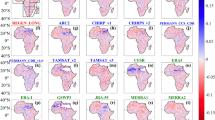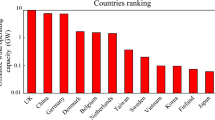Abstract
Accurate prediction of droughts is vital for effectively managing droughts, assessing drought risks and impacts, drought early warning systems, drought preparedness, and mitigation policies. This study integrated the extreme learning machines algorithm into the complementary ensemble empirical mode decomposition with adaptive noise (CEEMDAN) and variational mode decomposition (VMD) techniques to predict 1-month lead time meteorological and hydrological droughts. Standardized precipitation evapotranspiration index (SPEI) and standardized runoff index (SRI) values were calculated as meteorological and hydrological drought indicators, respectively. The effects of the previous SRI and SPEI values were evaluated to estimate 3- and 12-month SRI-based hydrological droughts. The previous SPEI values were used to estimate SPEI values. The cross-correlation matrix and partial correlation function were used to determine the model input combinations. It is recommended to input delayed drought indices up to 3 months as input to the model for predicting droughts with a lead time of 1 month. The performance of the models was compared with statistical indicators such as coefficient of determination, mean square error, and mean absolute error, and scatter diagram and violin box plot. As a result of the analyses, it was determined that decomposition techniques improved the drought prediction accuracy of the extreme learning machines (ELM) model. The highest prediction performance (R2: 0.926, MSE: 0.084, and MAE: 0.229) was achieved in the prediction of SRI12 (t + 1) values using the VMD-ELM hybrid approach with the input combination of SRI12 (t) and SRI12 (t − 1) values at the Hinis station. In addition, it has been revealed that the VMD decomposition method provides more successful separation than CEEMDAN in both SRI and SPEI estimations. The study outputs are essential in managing water resources, hydroelectric energy production, sizing of water structures, and transboundary waters.















Similar content being viewed by others
Data availability
Available from the corresponding author upon reasonable request.
References
Achite M, Jehanzaib M, Elshaboury N, Kim TW (2022) Evaluation of machine learning techniques for hydrological drought modeling: a case study of the wadi ouahrane basin in algeria. Water 14:431. https://doi.org/10.3390/w14030431
Agana NA, Homaifar A (2018) EMD-based predictive deep belief network for time series prediction: an application to drought forecasting. Hydrology 5:18. https://doi.org/10.3390/hydrology5010018
Ahmadi F, Mehdizadeh S, Mohammadi B (2021) Development of bio-inspired-and wavelet-based hybrid models for reconnaissance drought index modeling. Water Resour Manag 35(12):4127–4147. https://doi.org/10.1007/s11269-021-02934-z
Almikaeel W, Čubanová L, Šoltész A (2022) Hydrological drought forecasting using machine learning—Gidra river case study. Water 14:387. https://doi.org/10.3390/w14030387
Awange JL, Mpelasoka F, Goncalves RM (2016) When every drop counts: analysis of droughts in Brazil for the 1901–2013 period. Sci Total Environ 566:1472–1488. https://doi.org/10.1016/j.scitotenv.2016.06.031
Başakın EE, Ekmekcioğlu Ö, Özger M (2021) Drought prediction using hybrid soft-computing methods for semi-arid region. Model Earth Syst Environ 7:2363–2371. https://doi.org/10.1007/s40808-020-01010-6
Berg A, Sheffield J (2018) Climate change and drought: the soil moisture perspective. Curr Clim Change Rep 4:180–191. https://doi.org/10.1007/s40641-018-0095-0
Danandeh Mehr A, Fathollahzadeh Attar N (2021) A gradient boosting tree approach for SPEI classification and prediction in Turkey. Hydrol Sci J 66:1653–1663. https://doi.org/10.1080/02626667.2021.1962884
Das P, Naganna SR, Deka PC, Pushparaj J (2020) Hybrid wavelet packet machine learning approaches for drought modeling. Environ Earth Sci 79:1–18. https://doi.org/10.1007/s12665-020-08971-y
Dawson CW, Wilby R (1998) An artificial neural network approach to rainfall-runoff modelling. Hydrol Sci J 43:47–66. https://doi.org/10.1080/02626669809492102
Deo RC, Tiwari MK, Adamowski JF, Quilty JM (2017) Forecasting effective drought index using a wavelet extreme learning machine (W-ELM) model. Stoch Environ Res Risk Assess 31:1211–1240. https://doi.org/10.1007/s00477-016-1265-z
Di C, Yang X, Wang X (2014) A four-stage hybrid model for hydrological time series forecasting. PloS one 9:1–18. https://doi.org/10.1371/journal.pone.0104663
Dragomiretskiy K, Zosso D (2013) Variational mode decomposition. IEEE Trans Signal Process 62:531–544
Fijani E, Barzegar R, Deo R, Tziritis E, Skordas K (2019) Design and implementation of a hybrid model based on two-layer decomposition method coupled with extreme learning machines to support real-time environmental monitoring of water quality parameters. Sci Total Environ 648:839–853. https://doi.org/10.1016/j.scitotenv.2018.08.221
Gholizadeh R, Yılmaz H, Danandeh Mehr A (2022) Multitemporal meteorological drought forecasting using Bat-ELM. Acta Geophys 70:917–927. https://doi.org/10.1007/s11600-022-00739-1
Hezarani AB, Zeybekoğlu U, Keskin AÜ (2021) Hydrological and meteorological drought forecasting for the Yesilirmak river basin, Turkey. J Sustain Eng Pract Technol Dev 4:121–135. https://doi.org/10.51764/smutgd.993792
Hu J, Liu B, Peng S (2019) Forecasting salinity time series using RF and ELM approaches coupled with decomposition techniques. Stoch Env Res Risk Assess 33:1117–1135. https://doi.org/10.1007/s00477-019-01691-1
Huang NE et al (1998) The empirical mode decomposition and the Hilbert spectrum for nonlinear and nonstationary time series analysis. Proc R Soc Lond Ser A Math Phys Eng Sci 454:903–995. https://doi.org/10.1098/rspa.1998.0193
Huang NE, Shen Z, Long SR (1999) A new view of nonlinear water waves: the Hilbert spectrum. Annu Rev Fluid Mech 31:417–457. https://doi.org/10.1146/annurev.fluid.31.1.417
Huang G-B, Zhu Q-Y, Siew C-K (2006) Extreme learning machine: theory and applications. Neurocomputing 70:489–501. https://doi.org/10.1016/j.neucom.2005.12.126
Huang G-B, Zhou H, Ding X, Zhang R (2011) Extreme learning machine for regression and multiclass classification IEEE transactions on systems, man, and cybernetics. Part B Cybern 42:513–529. https://doi.org/10.1109/TSMCB.2011.2168604
Huang G, Huang G-B, Song S, You K (2015) Trends in extreme learning machines: a review. Neural Netw 61:32–48. https://doi.org/10.1016/j.neunet.2014.10.001
İkiel C (2005) Rainfall regime regions in Turkey (a statistical climate study). In: Forest impact on hydrological process and soil erosion symposium. pp 109–116
Katipoğlu OM (2022) Prediction of future hydrological droughts with treebased algorithms. Egitim Publishing Group, Turkey
Katipoğlu OM (2023) Prediction of streamflow drought index for short-term hydrological drought in the semi-arid Yesilirmak Basin using wavelet transform and artificial intelligence techniques. Sustainability 15:1109. https://doi.org/10.3390/su15021109
Katipoğlu OM, Acar R, Şengül S (2020) Comparison of meteorological indices for drought monitoring and evaluating: a case study from Euphrates basin. Turk J Water Clim Change 11:29–43. https://doi.org/10.2166/wcc.2020.171
Katipoğlu OM, Acar R, Şenocak S (2021) Spatio-temporal analysis of meteorological and hydrological droughts in the euphrates basin. Turk Water Supply 21:1657–1673. https://doi.org/10.2166/ws.2021.019
Katipoğlu OM, Acar R, Şenocak S, Şengül S (2022) Assessment of meteorological drought trends in the Euphrates Basin. Turk Arab J Geosci 15:1–14. https://doi.org/10.1007/s12517-021-08482-5
Labate D, La Foresta F, Occhiuto G, Morabito FC, Lay-Ekuakille A, Vergallo P (2013) Empirical mode decomposition vs. wavelet decomposition for the extraction of respiratory signal from single-channel ECG: a comparison. IEEE Sens J 13:2666–2674. https://doi.org/10.1109/JSEN.2013.2257742
Li G, Ma X, Yang H (2018) A hybrid model for monthly precipitation time series forecasting based on variational mode decomposition with extreme learning machine. Information 9:177. https://doi.org/10.3390/info9070177
Liu ZN, Li QF, Nguyen LB, Xu GH (2018) Comparing machine-learning models for drought forecasting in vietnam’s cai river basin. Pol J Environ Stud 27:2633–2646. https://doi.org/10.15244/pjoes/80866
McKee TB, Doesken NJ, Kleist J (1993) The relationship of drought frequency and duration to time scales. In: Proceedings of the 8th conference on applied climatology. vol 22. Boston, pp 179–183
Mehr AD, Vaheddoost B, Mohammadi B (2020) ENN-SA: A novel neuro-annealing model for multi-station drought prediction. Comput Geosci 145:104622. https://doi.org/10.1016/j.cageo.2020.104622
Mohammadi B (2023) Modeling various drought time scales via a merged artificial neural network with a firefly algorithm. Hydrology 10(3):58. https://doi.org/10.3390/hydrology10030058
Mouatadid S, Raj N, Deo RC, Adamowski JF (2018) Input selection and data-driven model performance optimization to predict the Standardized Precipitation and Evaporation Index in a drought-prone region. Atmos Res 212:130–149. https://doi.org/10.1016/j.atmosres.2018.05.012
Özger M, Başakın EE, Ekmekcioğlu Ö, Hacısüleyman V (2020) Comparison of wavelet and empirical mode decomposition hybrid models in drought prediction. Comput Electron Agric 179:105851. https://doi.org/10.1016/j.compag.2020.105851
Rilling G, Flandrin P, Goncalves P (2003) On empirical mode decomposition and its algorithms. In: IEEE-EURASIP workshop on nonlinear signal and image processing. vol 3. IEEER Grado, pp 8–11
Roushangar K, Ghasempour R, Alizadeh F (2022) Uncertainty assessment of the integrated hybrid data processing techniques for short to long term drought forecasting in different climate regions. Water Resour Manag 36:273–296. https://doi.org/10.1007/s11269-021-03027-7
Shukla S, Wood AW (2008) Use of a standardized runoff index for characterizing hydrologic drought. Geophys Res Lett 35:1548. https://doi.org/10.1029/2007GL032487
Soh Y, Koo CH, Huang Y, Fung K (2018) Application of artificial intelligence models for the prediction of standardized precipitation evapotranspiration index (SPEI) at Langat river basin. Malaysia Comput Electr Agric 144:164–173. https://doi.org/10.1016/j.compag.2017.12.002
Thornthwaite CW (1948) An approach toward a rational classification of climate. Geogr Rev 38:55–94. https://doi.org/10.2307/210739
Tosun H, Zorluer İ, Orhan A, Seyrek E, Savaş H, Türköz M (2007) Seismic hazard and total risk analyses for large dams in euphrates basin. Turk Eng Geol 89:155–170. https://doi.org/10.1016/j.enggeo.2006.10.003
Vicente-Serrano SM, Beguería S, López-Moreno JI (2010) A multiscalar drought index sensitive to global warming: the standardized precipitation evapotranspiration index. J Clim 23:1696–1718. https://doi.org/10.1175/2009JCLI2909.1
Wilhite DA (2000) Drought as a natural hazard: concepts and definitions. University of Nebraska, Lincoln
Wilhite DA, Glantz MH (1985) Understanding: the drought phenomenon: the role of definitions. Water Int 10:111–120. https://doi.org/10.1080/02508068508686328
Yeh J-R, Shieh J-S, Huang NE (2010) Complementary ensemble empirical mode decomposition: A novel noise enhanced data analysis method. Adv Adapt Data Anal 2:135–156. https://doi.org/10.1142/S1793536910000422
Yenigün K, Gümüş V, Bulut H (2008) Trends in streamflow of the euphrates basin, Turkey. In: Proceedings of the institution of civil engineers—water management, pp. 189–198 DOI: https://doi.org/10.1680/wama.2008.161.4.189
Zargar A, Sadiq R, Naser B, Khan FI (2011) A review of drought indices. Environ Rev 19:333–349. https://doi.org/10.1139/a11-013
Acknowledgements
The author thanks the general directorate for state hydraulic works and general directorate of meteorology for the data provided.
Funding
No funding was received for conducting this study.
Author information
Authors and Affiliations
Contributions
The author completes the work independently.
Corresponding author
Ethics declarations
Conflicts of interest
The author declares no conflict of interest.
Ethical approval
The manuscript complies with all the ethical requirements. The paper was not published in any journal.
Consent for publications
The author confirms that the work described has not been published before, and it is not under consideration for publication elsewhere.
Additional information
Publisher's Note
Springer Nature remains neutral with regard to jurisdictional claims in published maps and institutional affiliations.
Rights and permissions
Springer Nature or its licensor (e.g. a society or other partner) holds exclusive rights to this article under a publishing agreement with the author(s) or other rightsholder(s); author self-archiving of the accepted manuscript version of this article is solely governed by the terms of such publishing agreement and applicable law.
About this article
Cite this article
Katipoğlu, O.M. Integration of extreme learning machines with CEEMDAN and VMD techniques in the prediction of the multiscalar standardized runoff index and standardized precipitation evapotranspiration index. Nat Hazards 120, 825–849 (2024). https://doi.org/10.1007/s11069-023-06238-w
Received:
Accepted:
Published:
Issue Date:
DOI: https://doi.org/10.1007/s11069-023-06238-w




